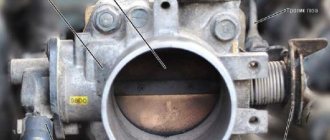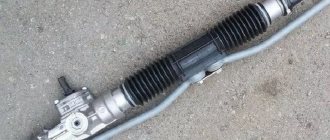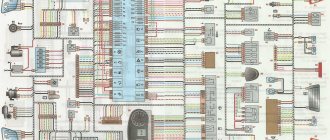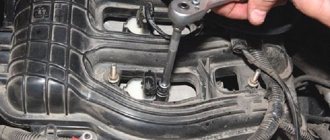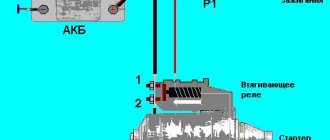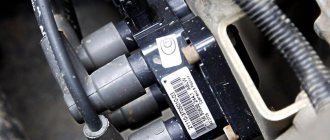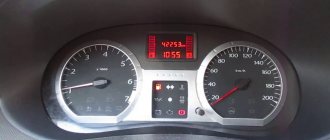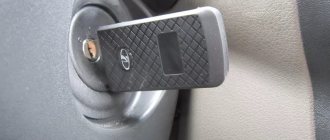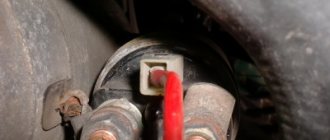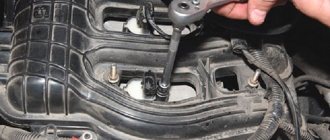Why the car won't start - the simplest option
If the Lada does not respond to turning the ignition key and at the same time does not turn the starter, then you should not look for a breakdown in the fuel system.
Everything may turn out to be much simpler or much more difficult. The most obvious option is a blown Granta fuse. First of all, check the one responsible for the cigarette lighter. By the way, there was some confusion with him. So, the diagram with which the car is equipped at the factory indicates that its number is F20. In reality, the required protective device is located at location F27.
The nuance is that the fuse is responsible not only for the cigarette lighter, but also for the immobilizer. If the latter is de-energized, the car will not be able to start. The check is very simple - press the horn (it is also powered through the mentioned device). If there is no signal, then the conclusion is obvious.
In general, problems with the immobilizer are indicated by the reluctance of the engine to start against the background of normal functioning of the dashboard backlight. At the same time, the indicator with the image of a key will also flash here.
To gain access to the mounting block, you will have to remove the decorative panel of the Lada steering wheel. Find the fuse and replace it. There is also a relay responsible for powering the starter. His number is K3. Study this element too. If there is no visible evidence of a malfunction, try installing a known good part into the socket and starting the engine.
If the Grant still does not start, then look for a breakdown further.
Engine and spark plugs
Often candles simply flood, especially in winter. This could be due to a weak battery spark, wiring problems, or unsuitable spark plugs.
The most primitive way to dry them is to press on the gas and crank the engine for 10 seconds using the starter.
But in winter this rarely helps, and the candles need to be dried. To do this, they need to be removed and thoroughly cleaned of dirt. This can be done with a toothbrush. In this case, you need to leave the same gap of 0.7-1 mm .
Probable Causes
When the starter does not turn when trying to activate the engine, this often indicates problems with the battery. Insufficient charge of the latter interferes with the functioning of the device in question, because it consumes a lot of energy.
Also, the Lada does not start due to damage to the starter electrical circuit or individual elements included in it. Inspect all wires leading to the device. Also check the fuse and relay if not already done.
The next obvious problem: oxidation of the battery terminals. Over time, a film of high resistance forms on them, which prevents the supply of current of the required strength. Clean them with fine sandpaper and tighten them with a wrench so that the wires do not dangle.
The ignition switch often prevents the Grant from starting. It is easy to make sure that it is faulty - just short-circuit the wiring leading to it. After this, the power plant should start.
When none of the above helped, and the Grant still does not start, it is permissible to assume the worst - a malfunction of the starter itself. Here, in particular, the following may fail:
It is difficult to perform diagnostics in the field, because the starter will have to be dismantled and disassembled. Failed elements are not repaired, but replaced with serviceable ones. All that can be done on the spot is to inspect the wires going to the device, remove them and clean them. Before doing this, do not forget to disconnect the negative cable from the battery.
As practice shows, the most common reason why the engine refuses to start and the starter does not turn is a weak battery charge, poor contact in the terminals or a breakdown of the Lada ignition switch. Other malfunctions occur much less frequently. Next we will tell you how to check.
The starter clicks but does not crank due to a faulty engine
If, when you try to start the internal combustion engine, you hear a strong click, but the crankshaft does not turn, it is likely that the engine itself is jammed. It must be said that this is one of the most unpleasant things that can happen to a car, but there are many different options here too, and not all of them are very sad. How do we diagnose in this case:
- set the gear to neutral, remove the starter;
- Using a large flat screwdriver, we try to turn the crankshaft by the teeth of the flywheel in one direction or the other;
- look carefully to see if there are any foreign objects or pieces of metal between the teeth and the flywheel housing.
In practice, various defects occur, for example, the aluminum Bendix housing may crack and get between the flywheel and the crankcase. It also happens that some bolt or other metal object flies into the intake manifold, then gets stuck between the cylinder head and the piston. If the bolt gets into the cylinder head, the crankshaft will easily scroll backwards, against rotation, and jam as the crankshaft moves. If a foreign object gets into the cylinder, you cannot start the engine, as there will be a strong knock in the engine, and the piston heads and combustion chambers may be damaged!
A bad option for engine jamming is turning the crankshaft liners; here, when you try to turn it manually, the shaft moves tightly, springs back, but still turns with difficulty. Melting of the liners always leads to a major overhaul of the internal combustion engine; there is no other way out; in the worst case, the cylinder block may be punctured.
Nothing brought early cars closer to mass appeal than the invention of the electric starter: the starting handle was both inconvenient and unsafe. Over more than a hundred years of use, the design of automobile starters has been “polished” almost perfectly, but even now it causes problems. The most typical of them is clicking noises under the hood when starting the engine, but the starter does not turn the engine.
Regardless of the specific design (geared/gearless, with or without a stator winding), the electric starter includes a solenoid relay. This electromechanical unit performs two functions simultaneously:
- It pushes the bendix and drive gear forward, allowing it to mesh with the flywheel ring gear.
- It relieves the load on the ignition switch contacts: the current consumed by the starter is large, and the solenoid relay allows you to control the starter using a relatively small current.
The design of the solenoid relay is simple: its body houses two windings of different power, which draw in (hence the name) the core. A fork is installed on the core, which moves the bendix through a lever, and at the end of the stroke the core closes power contacts (“nickels”) that supply power to the starter directly from the battery. Two windings are used to reduce current consumption: more force is required to retract the core than to hold it in place. As soon as the core of the pull-in relay closes the “nickels”, the pull-in winding is bypassed, and only the holding winding works.
Checking starter Grants
When the Lada engine does not start, and the manipulations with the battery described above did not help, you will have to deal with the starter. There are many elements in this unit that can fail.
Options, in addition to those discussed in this article, include the following:
Most often, problems arise in the solenoid relay. It is quite easy to verify that there is a problem with it. It should be powered directly from the battery. Apply electricity to its control terminals (they have nuts on them). If you hear a click, then the armature is ok, and then there may be a problem with the contacts. They burn out over time and stop conducting current. Open the relay housing and clean them with a file. The trouble is that such prevention will not last long. Therefore, try to replace the relay as soon as possible.
The car may not start due to damage to the bendix. This part is responsible for transmitting the starter torque to the power plant through the clutch to the flywheel. If the bendix teeth are worn out, the motor will not be able to operate normally.
When the car does not want to start, and the starter does not make any sounds at all, then one should suspect the most serious of possible breakdowns - a break or short circuit of the winding. Of course, it is possible to repair it, but the work will cost a lot of money, which will be enough to buy a new part.
Problems with the immobilizer (APS)
Often the Lada Granta does not start due to improper operation of the APS. If it is activated, the key is read and the engine starts. The immobilizer (APS) identifies the “native” key by reading the code from it.
If it is incorrect, then the APS blocks the operation of all vehicle systems. Here it is necessary to immediately clarify that APS is not activated upon sale in all trim levels. Lada Granta sedan is equipped with an anti-theft alarm in models 023, 024 and 050.
Lada Granta liftback in the 711, 713, 750 and 751 configurations. Many car dealers cheat when selling and say that the immobilizer cannot be activated. But by law they must do this at the request of the car owner.
If the key is not registered, the indicator lights up continuously for about 20 seconds. without blinking, and then goes out. During training, blinking occurs at a frequency of 5 Hz, at the end of training at a frequency of 10 Hz. When problems arise in the system, a sound alert is added to the light indication; it appears at the 10th and 20th second.
Decoding signals:
1 signal + flashing indicator – the code from the key cannot be read, possible reasons:
- problems in the communication coil circuit. In this case, you need to check the resistance and inspect the circuit;
- There is no transponder in the key. To eliminate the problem in the training key, you should check the presence of the transponder and its markings; if it is missing, then use a “clean” key and the CSUD to retrain the entire system;
- The transponder (located in the red key, you need to remove the red head) may be broken. In this case, for a training key, you need to retrain the system with a clean key, and for a working key with a remote control, you need to replace the remote control with a new one and train the system again;
2 beeps + flashing indicator – the relationship between the APS and the ICS is broken, possible malfunctions:
- There was a communication failure on the w line. In this case, it is necessary to eliminate violations in the chain between the APS and the ICS;
- violation in the APS and KSUD chain. It is necessary to replace them one by one to identify where the malfunction occurred;
- there is no voltage on the APS and KSUD power supply. In this case, you need to check and restore the voltage.
3 beeps + intermittent indication - “foreign” key or APS. In this case, it is necessary to carry out training using a “clean” key and a “clean” KSUD. For APS, you need to configure the system using a training key native to the ICS.
4 signals + flashing indicator – the controller does not provide confirmation to start the engine. This suggests that the KSUD has already been trained with another system; it needs to be changed to a clean one and retrained.
To find out exactly the cause, it is necessary to make a diagnosis. If the controller is broken, it must be replaced and re-learned.
If there is an APS, then you need to replace it and train it along with all the working keys, since structurally in the Lada Granta the APS is located in the instrument cluster.
Lada Granta does not start: the starter does not turn. What to do
The most unpleasant thing about any breakdowns is that they appear unexpectedly. Inexpensive cars like the Lada Grant suffer from this most often. The engine does not start, the starter does not turn. There are more than enough options for solving the problem for an experienced auto mechanic. And an inexperienced person is unlikely to be able to overcome such a problem on their own. But we are experienced...
Signs of a faulty starter
There are actually many reasons why a car won't start. However, a faulty starter can be determined by the appearance of one or more of the following symptoms:
- the starter does not turn on;
- the starter clicks, but does not turn the engine crankshaft;
- when the starter is turned on, the crankshaft rotates very slowly, which is why the engine does not start;
- You can hear the metallic grinding sound of the Bendix gear, which does not mesh with the crankshaft.
Next, let's move on to discussing the possible causes of a possible breakdown. In particular, we will analyze situations when the starter either does not rotate at all or does not rotate the engine crankshaft.
The starter does not turn on the Lada Granta. Where to look for the reason
In any situation when the engine of a Lada Grant does not start and the starter does not turn, you need to proceed from what exactly went wrong and what foreshadowed this. For example, when you turn the ignition key, the starter does not show any signs of life at all, but the instrument panel lights up as if nothing had happened and the fuel pump hums. But it also happens differently. Now we will try to simulate several situations and one of the solutions should work exactly.
The starter does not turn, the instrument panel does not light up
When you turn the ignition key, the car is more dead than alive - nothing happens. But we know that with proper electrical equipment and battery power, at least something should come to life. We conclude that the battery charge has dropped below critical, or there is no contact at one of the terminals. In addition, we check the quality of the contact of the ground wire from the battery to the body.
Unscrew, clean, tighten. Now let's measure the battery charge. If you don’t have a tester, it doesn’t matter, you can check with a simple 12-volt lamp and understand from the intensity of the filament that there is no charge at all or the reason is something else. To test this option, it would be good to have a 100% working battery on hand.
The starter does not turn on the Grant, the tidy is on. Immobilizer?
If, when you turn the ignition key, the dashboard lights up and you can hear the operation of the fuel pump, we will look for the reason in the following: for unknown reasons, AvtoVAZ engineers put it on the same line with the standard immobilizer. What prompted them to do this is unknown, but if we overloaded the fuse the day before by turning on some powerful device, then the fuse may not withstand restarting.
Everything is simple here. We install a new 15A fuse, according to the diagram it is called F20 and is installed in the interior mounting block, after making sure that the old one has burned out. If this is the cause of our troubles, good. But it could be different. The immobilizer is a capricious thing. If we see a warning light on the dashboard with a flashing key, and the starter does not turn, we need specialist intervention.
The lamp may remain on for 10 seconds and then go off. This is a sure sign that the immo is disabled or not activated.
When we are sure that everything is in order with the wiring and voltage, it may be necessary to retrain the key. We figured out how this is done not long ago.
Starter circuit: fuses, relays and contacts
Everything is obvious here. If the immobilizer lamp does not blink, we are looking for trouble in the starter circuit. In the case when the fuel pump does work. We start with the fuse and relay:
Just in case, the location of the relays and fuses is duplicated on the covers of the mounting blocks, and to get to the interior unit, it is enough to unfasten the plastic casing and overcome the force of five latches. The cover is located to the left of the driver.
Next, if the Grant does not start and the starter still does not start turning, open the hood and find the starter. We carefully examine all the wires connected to it, in particular the power ones. If there is too much dirt or rust on the back of the starter, there is a chance that the contacts have oxidized. We unscrew the starter terminals (after first removing the negative terminal from the battery), clean the terminals and put everything back in place.
Starter and how to deal with it on Grant
Actually, we can say with a high degree of probability that the starter windings have come to an end if we don’t hear any sounds from under the hood when we turn the key to the “start” mode. The windings can be rewound, but it is cheaper to buy a new or used starter.
We turn the key, and from under the hood we hear clicking and clattering noises, but the starter does not turn. This is better, since in this case all the signs of burnt contacts of the solenoid relay are evident. This can be solved by a few hours of fiddling with dismantling the starter and cleaning or replacing the “nickels” and contacts of the solenoid relay. In any case, the involvement of the retractor and the rest of the starter circuit in the breakdown can be found out by closing the contacts with a powerful screwdriver: if the starter works in this case, you need to look in the circuit before it.
Starter solenoid relay
Among the mechanical reasons for a non-working starter, wear of the overrunning clutch gear and bendix is often noted. When the gear teeth are licked, it cannot engage with the flywheel ring. But then the starter motor will spin and we will hear the grinding of teeth. This can be treated by replacing the bendix.
Voltage drop in the circuit or non-contact
One of the reasons why the starter may refuse to work may be a voltage drop in the on-board network under load. We know that the minimum voltage to start the engine must be at least 11.4 Volts. The normal value is 12-14.5 V. The voltage in the network can be viewed on the on-board computer or measured with a multimeter directly at the starter contacts - plus at the power terminal, minus at ground with the ignition on.
We measure the voltage on contacts C and D
The most logical solution in this case is to charge the battery or light a cigarette from another car and let the engine run for 10-15 minutes to charge the battery.
In addition to the above reasons, there are more complicated moments. For example, the electronic engine control unit may malfunction and then the starter may simply not turn when the key is turned to start mode. In other cases, when the engine of a Lada Granta does not start, but the starter still works and turns, we will look into it next time, since this is a completely different story.
Source
If you hear one click
A powerful single click in the starter, after which the starter continues to be at rest, can indicate various reasons, including:
- failure of the solenoid relay, resulting in the start blocking;
- the contacts on the power cable are burnt;
- there is a winding break inside the unit;
- damage to starter bushings or brushes;
- Bendix malfunctions.
If in most cases the problem is solved by replacing a damaged or worn element, then with the starter bendisk everything is much more complicated.
Bendix is an important element of the car's starting system, which is located in the starter. When it is deformed, problems often arise with starting the engine, so you should devote enough time to servicing the Bendix. As a rule, the most common Bendix malfunction is a broken fork or working gear teeth.
Since the bendix is closely connected to the retractor relay, without full retraction when the starter is turned on, there will be no clutch between the flywheel and the teeth. As a result, the engine will not be able to start. Even if the starter fires the second time, there is no need to ignore this “symptom” and put off a trip to the mechanic until later. You may not be able to start the engine at the most inopportune time and you will have to look for a solution to the problem.
Simple and fast
The easiest way to deal with the power source is the battery. Sometimes it tends to run out of charge, and if it started to run out recently, you might not have noticed it yet. If you have a voltmeter tester, checking is a matter of seconds. If it is not there, you can use the old-fashioned method (although it is not very approved by firefighters): remove the wires from the terminals and rub them against each other.
There is a spark (which is why the firefighters are protesting) - the battery is working. If you don’t want to violate safety rules, just listen to the car’s reaction: a slight jolt at the first stage directly indicates a low battery.
The second reason, equally common and easy to eliminate, is oxidation of the terminals or their contamination. Clean them with a wire brush (probably lying in the trunk) - and the car will start.
The next thing to check is the fuses
. They often burn out, and most more or less modern cars have an ignition control. The circuit is removed from the glove compartment and it becomes clear which one needs to be checked; if it burns out, replace it, and that’s the end of it.
Causes of clicking noises when starting the engine, checking and solving the problem
Solenoid relay malfunctions
Thus, it is not difficult to think of reasons why the click of the retractor relay may not be accompanied by activation of the starter. The simplest of them is power problems: dead battery, oxidized terminals. At the moment when the solenoid relay turns on the starter winding, a sharp drop in voltage occurs, and with it, in strict accordance with Ohm’s law, the current in the holding winding. The energy of the magnetic field is no longer enough to counteract the retractor return spring, and the core moves outward, breaking the starter circuit. Depending on the condition of the car and the battery, this results in either a single click from the starter or a “machine-gun burst” of clicks from under the hood.
Therefore, the first thing you should check is the battery charge, inspect the terminals on the battery and, if necessary, clean them. Having already guaranteed the supply of electricity “as intended,” we proceed to further verification.
More severe cases
It’s a little sadder if the ignition switch itself is covered. After the initial check and cleaning, the key is inserted and turned to the first position. At the same time, the warning lights and instruments on the dashboard should light up. If there are no signs of life, electrical enthusiasts can ring this unit themselves, or even replace it without outside help. The rest are looking for someone to attach the cable to and go to the service station: they may have to disassemble the half-torpedo in search of the cause (which could be any frayed wiring. Then at least you won’t have to change the lock).
Another component available for checking is the starter itself. To make sure everything is fine with it (or vice versa), you will need an assistant and, again, a tester. One person turns the key, the second holds the wire of the device on the wire that supplies voltage to the starter. The main thing here is to position yourself so that the rotating part does not catch the controller if the starter is normal. If there is voltage, but the starter does not respond to it, it will have to be repaired.
If the starter spins but there is no feedback, a completely different story begins:
If you have checked all this, found and corrected some shortcomings, and the car still does not respond to the ignition key, you will have to accept the inevitable and drag it to a car service in tow. To do this, you can use a neighbor in the garage or just an acquaintance. Or you can use a tow truck, but this will cost a certain – and considerable – amount. Then a professional electrician at the nearest service center should look for the reason for the stubbornness of your car - an amateur has very little chance of this.
The immobilizer of the Lada Grant and any other car is a special anti-theft device that does not allow the engine to start. Motorists use it very rarely, even if the Lada Granta immobilizer is included, while others simply do not know about the existence of such a device. But safety cannot be neglected, and that is why all owners of Lada Granta, without exception, should be sure to familiarize themselves with the design and operating principle of this module.
The moment the driver inserts the ignition key, the Lada Granta immobilizer is identified using a code. If there is a match, there are no obstacles to starting the engine and you can start moving. Otherwise, the car will be locked until the correct code is received. There is one important disadvantage of using this device - if the Lada Granta immobilizer breaks down, then it will be possible to start the car only after repairing or replacing the module. In such a situation, the old code is deleted from the controller and new code is written. So, if the immobilizer is blinking, you should think about it and pay attention to it.
At the car dealership, the Lada Granta immobilizer is activated during the pre-sale preparation procedure under the supervision of the future owner. If the buyer refuses to use this function, then this is entered into the service documents, where it is certified by the seal of the car dealership and the signature of the buyer.
Checking the functionality of the solenoid and contact relay
When the VR is not working well, when you try to start the engine, clear dry clicks are heard; if the cause of the defect is a contact relay, the clicking in this case is quiet and quite soft. First, we check the functionality of the starter itself, this is done something like this:
- remove the starting device from the car;
- We connect the terminal wires to the removed battery, connecting their other ends to the main positive and ground of the starter;
- we connect another wire to the starter winding, with its other end we touch the positive terminal of the battery, while holding the starting device;
- if the starter is working, the bendix will engage, the rotor will rotate, if not, there will be no rotation, and when voltage is applied, slight sparking will occur;
- To completely make sure that the starter does not respond or, on the contrary, responds to the power supply, we apply plus directly to the winding.
Now, without disassembling the starter assembly, you can check the operation of the solenoid relay:
- apply minus to the winding output;
- briefly touch the BP contact pin, where power is supplied from the ignition switch (on many cars this contact is equipped with a “chip”);
- when power is applied and the relay is working properly, a clear click will be heard, and the bendix will move backward;
- if the bendix does not come out, you need to disassemble and diagnose the solenoid relay.
You can also check the VR when it is removed from the starter; here we also supply power with wires from the battery (plus and minus). When “+” is applied to the control contact, the core on a working relay will be retracted; if the VR is faulty, the full stroke of the core is not observed.
The starter contact relay (SCR), which is usually located inside the car or in the engine compartment on the panel next to the windshield wipers, may also be faulty. In this case, when you turn the ignition key, faint clicks may be heard, or more often no sounds can be heard at all. Before you start checking the RPC itself, you need to make sure that power is supplied to the relay. It is convenient to check the presence of voltage using a test light by connecting the ends of the probes to the corresponding terminals; the minus here should be constant, and the plus should appear at the appropriate position of the ignition switch (Z.Z.).
It should be taken into account that each car model has its own circuit, some cars have a starter blocking relay installed (has a different purpose), some cars do not have a starter lock relay at all. You need to check the chain according to the electrical diagram, but the principle of operation, we assume, is generally clear. If the plus does not come to the corresponding contact in the block, the 3Z contact group is probably faulty, there may also be a break in the wires, a poor connection in the blocks, in some cases, upon careful inspection, you can see traces of melted insulation.
The ECR itself is also checked using a test light or a multimeter, but when searching for a defect on your own, it is more convenient to have a working relay in stock, given that the part is inexpensive and is almost always available in car dealerships.
Two ignition keys on a Lada Granta car
The first is suitable for everyday use and can be supplemented with a remote control device. This key removes the engine lock. This means it deactivates the immobilizer of the Lada Grant.
The second one is necessary for training the Lada Grant immobilizer. Where is the immobilizer located? Usually marked with a red mark. It is suitable not only for starting the internal combustion engine and making changes to the engine blocker settings, but is also designed to control the blocking of all doors without exception. This key should be used only in extreme cases and kept in a safe place. If the training key is lost, the dealer will not service the anti-theft system under warranty.
A detailed algorithm for reconfiguring the immobilizer
First of all, you need to close all the interior doors and insert the so-called training “red” key and activate the engine ignition. If the indicator glows steadily, it means that the training procedure should be carried out. Next, you need to turn off the ignition and wait until the immobilizer flashes. Remove the “red” key and immediately insert the regular one, turn on the ignition as usual. At the same time, you will first hear three short beeps in a row, and after a short period of time a couple more. Then turn off the ignition again and reinsert the first training key - three short beeps must sound in the same way and after the same two short beeps. Turn off the ignition and do not remove the learning key. This will be followed by one short signal, and the indicator will quickly and quickly flash. Turn the ignition on and off again, after which 3 beeps will sound and the indicator will turn off completely. Now you can remove the training first “red” key and use the usual one to test start the engine. This is how the immobilizer for Lada Granta works.
If the starter doesn't turn
A fairly common situation is when the inability to start the car is accompanied by poor performance of the starter. There may be quite significant problems hidden in this. In addition to what we have already said regarding the battery and its terminals, it is worth checking the entire electrical circuit of the starter. To do this, it is necessary to inspect all the passages of wires and connecting components.
Try to close the starter directly with a screwdriver; if the car starts, you should pay attention to the wiring and protection elements (fuse, relay).
When searching for faults that may affect engine starting, you should start with the fuse box.
Remove the decorative cover under the steering wheel to gain access to the mounting block. Remove the starter relay and inspect it for external damage. If possible, replace it with a known good one to check its operation.
Starter relay on fuse box diagram
But you can also install a bug. The bug needs to be installed only temporarily; such a “collective farm” cannot be left permanently.
Using a jumper wire to test a contact relay
Technical breakdowns of the starter itself
This is followed by such a disadvantage as malfunctions relating to the starter drive parts. You can verify this by checking the starter, and, if necessary, it will have to be repaired. To repair the starter, it must be removed from the vehicle.
Starter location under the hood
If everything is in order with this, then it would be a good idea to check how well the electric starter motor works. In general, you need to look at the armature and windings, as well as the brush assembly.
Once everything is clear with the starter, you can move further along its circuit. This applies, first of all, to the ignition switch.
Bendix failure
It, the bendix, or other components may break. The main signal of poor Bendix performance is extraneous crunching and knocking noises when starting the engine. In the video below you can clearly hear that the Bendix does not work well when starting the engine.
Also check the ignition switch wires for fraying.
And, of course, it would not be amiss to conduct a visual inspection of the flywheel ring gear. If it has visible damage, or is worn out quite badly, then there is only one option - to completely replace the crown.
Computer malfunction
There are significant flaws in the body design; the drainage holes near the filter are often clogged with dirt and water gets into the block through them.
To do this, you need to check and clean the drainage more often. Also, water can flood the ECU after installing the alarm, when the plugs are not installed tightly or they are completely forgotten to be installed.
You can try to dry the block, but if this does not help, you will have to replace it. This problem can be partially solved by wrapping the block with film or filling it with sealant, but then this is fraught with the appearance of condensation inside the ECU.
It is not difficult to remove the ECU; it is located opposite the front passenger seat, under the glove compartment, behind the soundproofing upholstery, almost on the floor, near the passenger’s feet.
ECU removal sequence:
- Disconnect the on-board network.
- Remove the screw that secures the upholstery.
- Carefully peel back the upholstery and sound insulation layer.
- Unscrew the three nuts securing the ECU.
- Carefully move the unit to the side and remove the two wire clamps one by one.
After unscrewing the computer, you need to disassemble it and assess the extent of the damage. We remove the board from the case and carefully inspect it. If it is partially burnt out and blackened, then nothing can be done about it; it needs to be replaced.
But if the board has no visible damage or only the output key has burned out, then in this case the key must be replaced, and the board must be washed and dried. First, you need to wipe it with a clean rag, then rinse it with WD-40 and blow it out with a compressor.
After this, rinse with alcohol several times and blow again. Now the most crucial moment is drying. Using a hair dryer set for a maximum of 1.5 hours, we blow through the board on both sides.
Other reasons why the Lada Granta does not start
There are many possible breakdowns. To begin with, it’s a good idea to check the battery charge level, since you won’t be able to start without a battery. Also, make sure that the terminals on the battery are tight and have not oxidized. If the car is already three years old, then special attention should be paid to the issues of terminal oxidation.
Keep in mind that after prolonged cold weather, the charge level may drop to one third of its original volume. If necessary, the car can be covered with a special cover, which will save the accumulated heat for a long time.
Malfunctions may also affect the fuel system. Similar reasons are typical for situations when the car starts, but immediately after that it stalls. If so, then most likely the problem is a burnt out fuel pump.
And, of course, do not forget that the spark plugs may simply deteriorate. This happens after prolonged operation of the power unit at high speeds. To prevent them from burning out, you need to periodically clean their contacts, as well as maintain the normal operating parameters of the car.
Among other things, it would be a good idea to inspect the air filter. Before doing this, the air filter must be removed from the car. If it is too clogged, soot can accumulate in the cylinders, which will lead to certain problems in the operation of the machine.
Ignition timing
Changing the ignition timing
The top photo shows a boat motor, the throttle handle is in the “idle” position. Magneto base 1
in the “small ignition timing” position, the carburetor throttle valve
2
is closed
(the throttle valve drive is visible)
.
When “gas” is added, the base of the magneto rotates towards a “larger ignition timing”, and at the same time the carburetor throttle begins to open. In the bottom photo the throttle handle is in the “full speed” position. Compare the relative position of parts 1
and
2
.
Rotation of flywheel 3
clockwise.
The most important parameter that determines the operation of the ignition system is the so-called ignition timing
, - that is, the time at which the system ignites the compressed working mixture with a spark discharge.
The ignition timing is determined as the position of the engine crankshaft at the moment the impulse is applied to the spark plug in advance
relative to the top dead center in degrees (typically from 1 degree to 30).
This is due to the fact that it takes some time for the combustion of the working mixture in the cylinder (the speed of propagation of the flame front is about 20-30 m/s). If you ignite the mixture with the piston at top dead center (TDC), the mixture will burn already on the expansion stroke and partially on the exhaust stroke and will not provide effective pressure on the piston (simply put, it will fly out into the exhaust pipe when it catches up with the piston). Therefore, the (optimal) ignition timing is selected in such a way (advanced relative to TDC) that the maximum pressure of the burnt gases occurs at TDC.
The optimal ignition timing depends on the speed of the piston (engine speed), the degree of enrichment/leanness of the mixture and slightly on the fractional composition of the fuel (affects the combustion rate of the mixture). To automatically bring the ignition timing to the optimum, centrifugal and vacuum regulators or an electronic control unit are used.
It should be noted that under load conditions in gasoline engines at optimal (according to the combustion rate of the mixture) ignition angles, detonation often occurs (explosive combustion of the mixture), therefore, to avoid it, the actual ignition timing is made slightly smaller, up to the threshold of detonation (by supplying the initial advance angle manually, or by the electronics of the control unit - automatically, in motion). In modern engines, the control program constantly sets the ignition angle a little earlier, constantly moving the ignition to the early side, in small steps of fractions of a degree, and at the moment the detonation criterion appears, the program shifts the ignition a few degrees to the late side, then the process repeats. As a result, the system “guides” the ignition timing to the edge of detonation, which helps to obtain maximum performance from the engine. Since the introduction of the EURO-3 standard, ignition timing has been controlled separately for each cylinder.
Both “late ignition” and “early ignition” (relative to the optimal one) lead to a drop in engine power and a decrease in efficiency due to a decrease in efficiency, as well as excessive heating and stress on engine parts. “Early ignition”, in addition, leads to strong detonation, especially when the gas pedal is pressed sharply. Adjusting the ignition timing on cars usually involves setting the earliest ignition timing that does not yet lead to detonation during acceleration.
